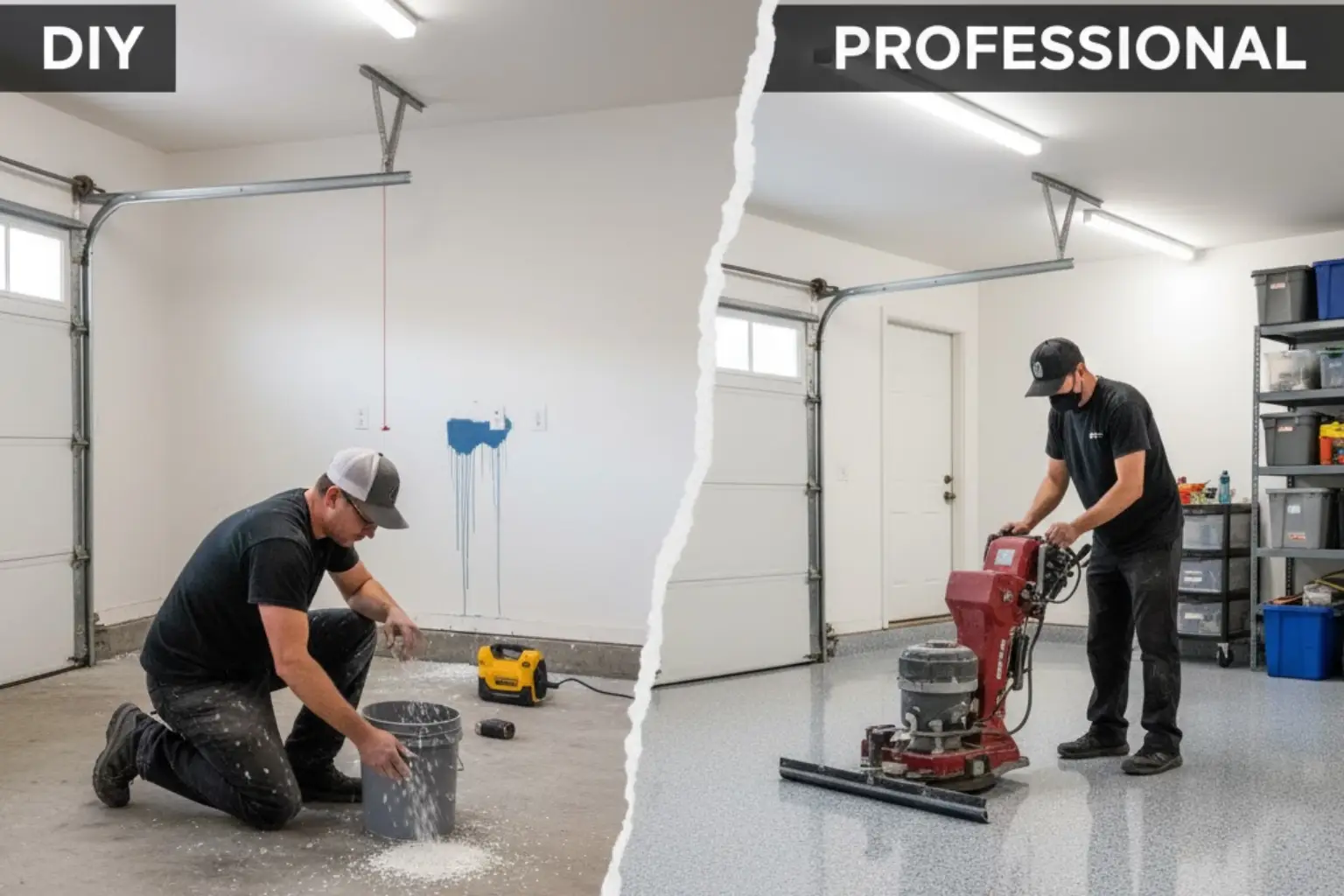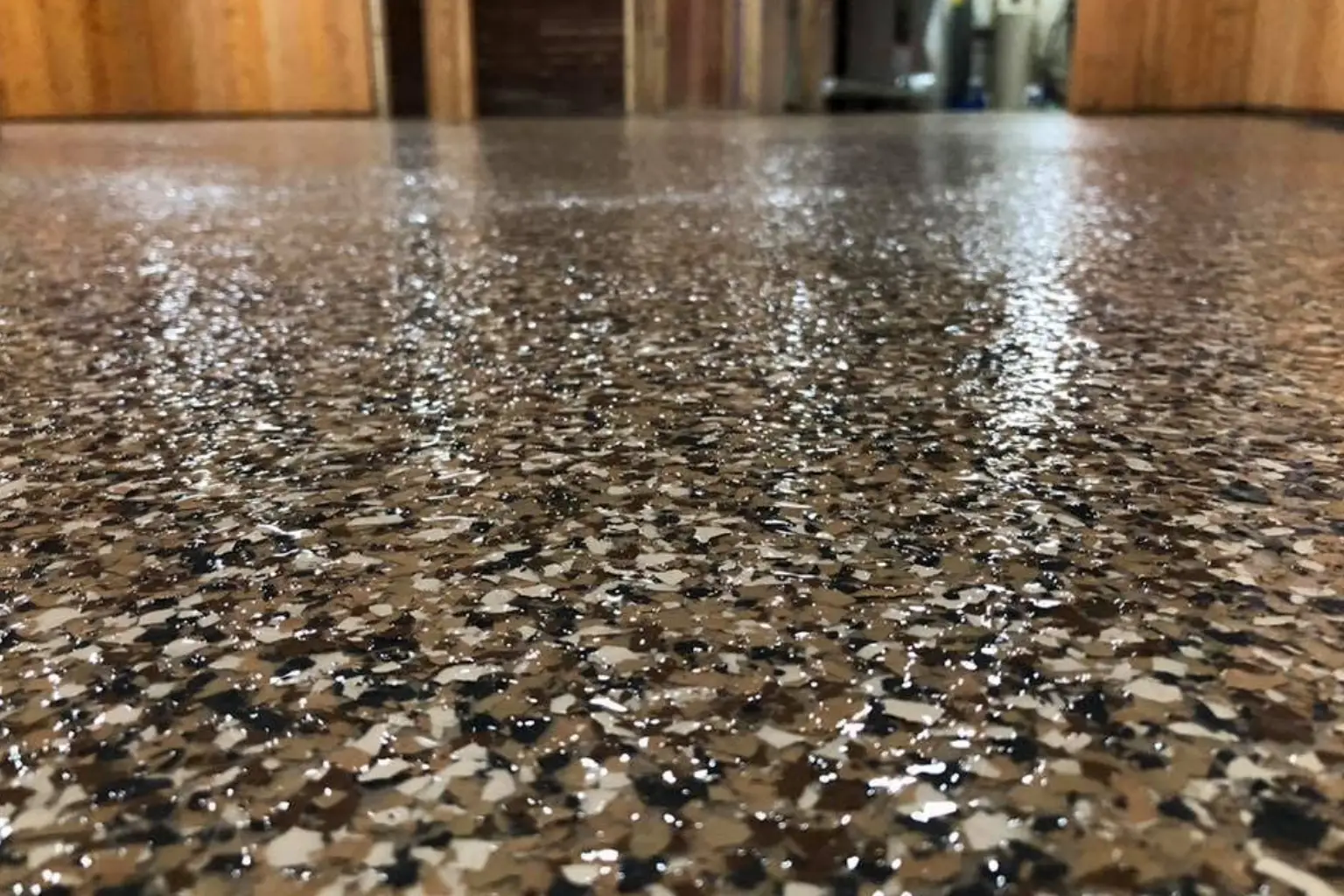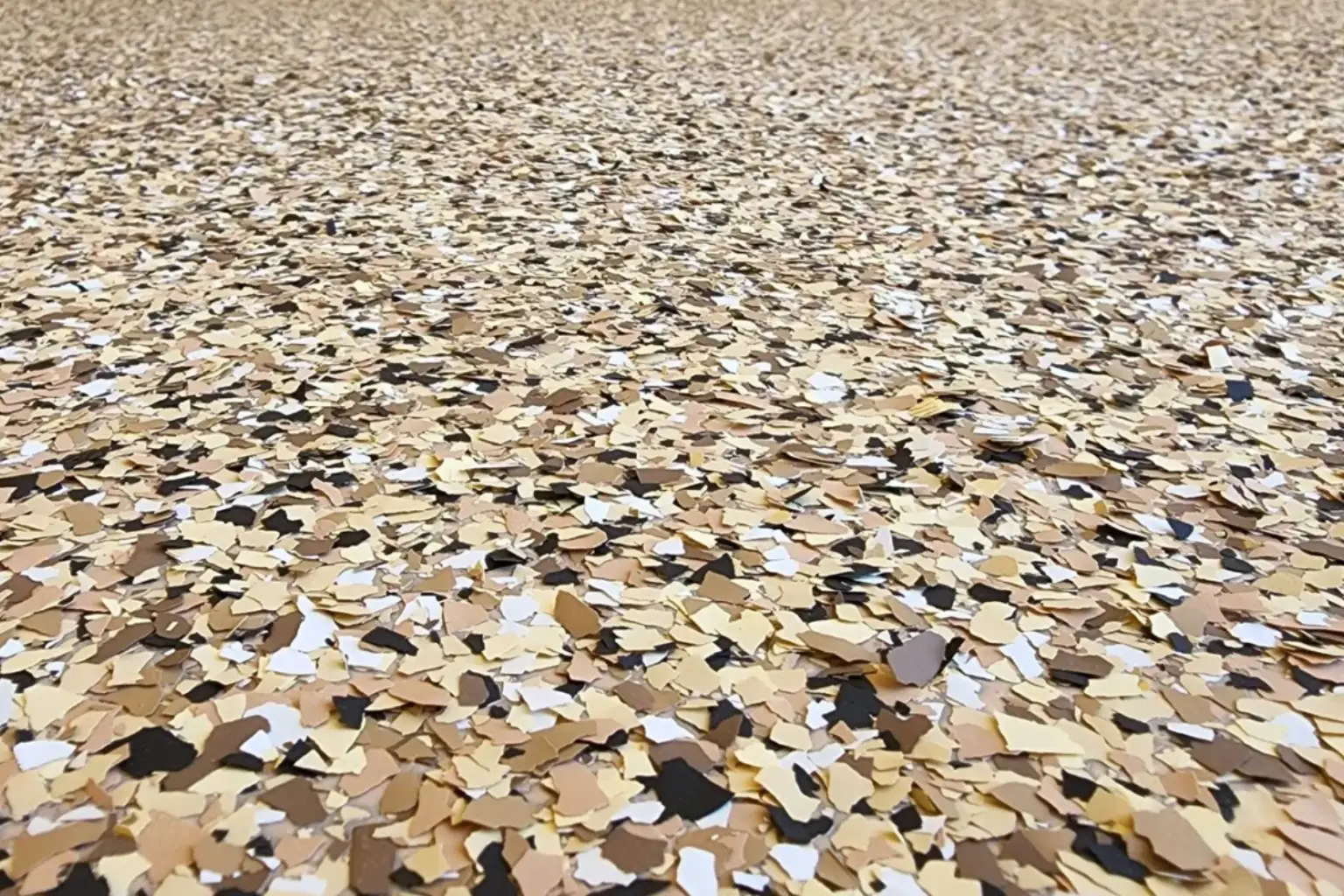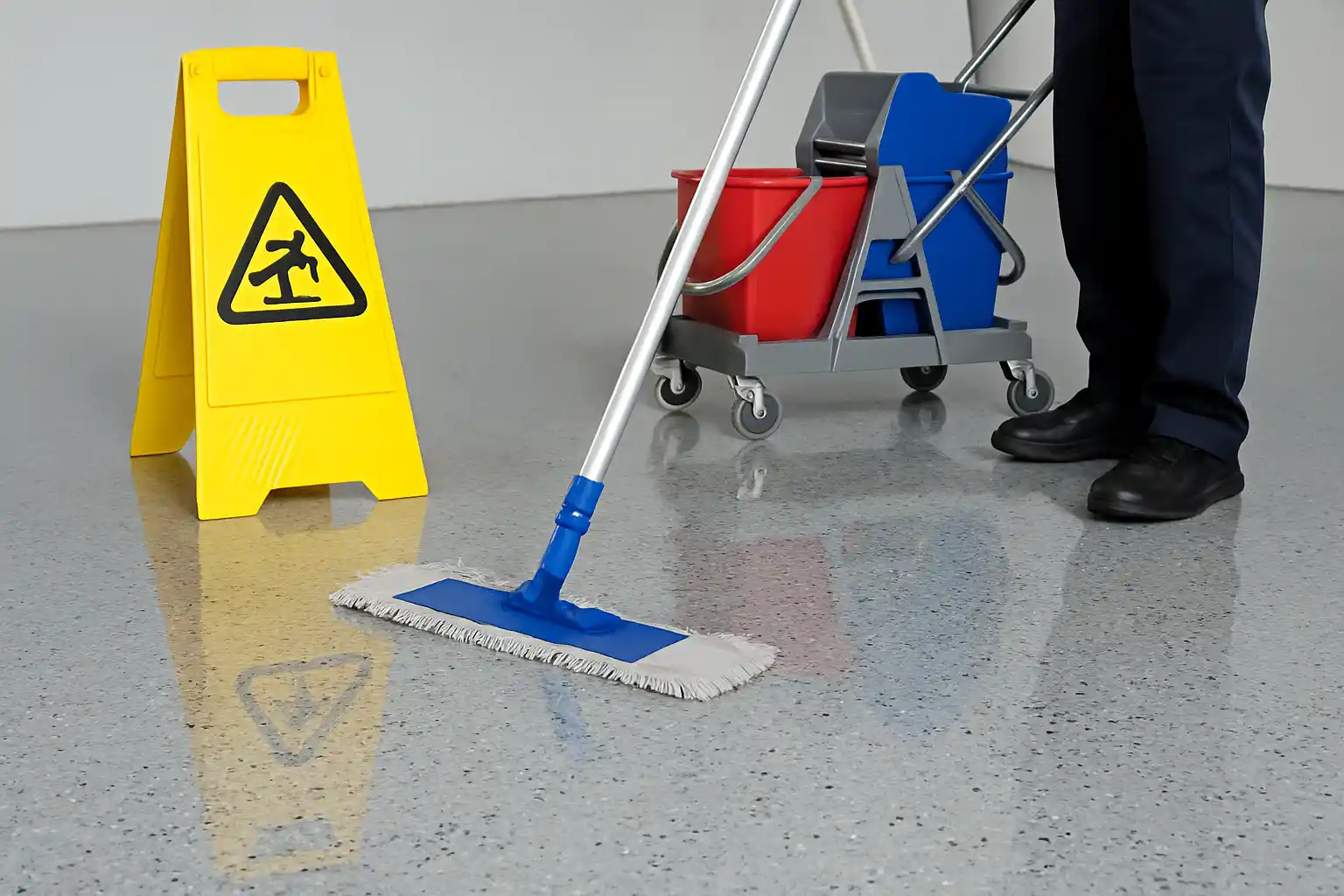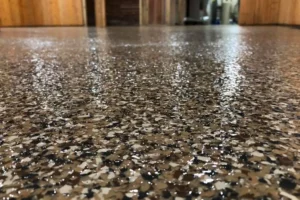Epoxy flooring is strong, shiny, and low-maintenance. However, to keep it looking new and in good condition, it requires proper cleaning and upkeep. Knowing how to clean epoxy floor coating the right way helps protect its shine and makes it last for years.
This guide will cover the best epoxy floor cleaning tips and ongoing maintenance to help your floors stay clean, safe, and shiny for years to come.
Why Epoxy Floor Maintenance Matters
Epoxy floors are low maintenance, but that doesn’t mean they don’t need any upkeep. Even the toughest epoxy coatings cannot resist wear and tear over time without proper care and may become dull or tarnished.
- Daily issues such as dust, spills, foot traffic, or driving on the surface can gradually cause damage and shorten its lifespan. That’s why regular epoxy floor cleaning and maintenance is essential.
- Periodic cleaning helps preserve the high-gloss, reflective finish of metallic epoxy floors.
- Dust and grime can make the surface look dull and neglected, especially in areas with heavy foot traffic.
- Epoxy floors can be slippery when covered with dirt, oil, or moisture, which poses safety risks in garages or commercial sites. Proper cleaning reduces the risk of accidents.
- For commercial epoxy floor maintenance, routine cleaning is crucial to handle heavy traffic, machinery use, and chemical exposure. Regular cleaning saves money by avoiding the need for costly repairs or repainting.
- For homes and businesses, a clean, tidy epoxy floor enhances the overall appearance and can even increase resale value.
Daily Epoxy Floor Cleaning Tips
Keeping up with daily cleaning prevents dirt and grime from building up and damaging the surface. It also makes deeper cleanings easier and more effective.
1. Sweep or Dust Mop Regularly
The first step is to remove loose dirt and debris from your epoxy floor to keep it shining and durable. Clean epoxy floor at least three to four times a week, depending on traffic, using a soft boar brush or microfiber mop. This helps reduce the risk of scratching the surface from small particles like sand, dust, or grit when walked or driven over.
Epoxy coatings rarely scratch or wear down the top layer, so avoid stiff-bristle brooms, coarse brushes, or rough cleaning tools that can damage the surface over time. A gentle brush will maintain the shiny appearance of the floor.
2. Spot Clean Spills Promptly
No matter how cautious a person is, spills are unavoidable. This is more likely to occur in the kitchen epoxy flooring, garage, or spaces that are frequently used. If liquids such as oil, water, chemicals, or even juice are left on the surface, they will cause stains or make the floor slippery. This is why you must clean off any spills immediately after they happen.
Clean the spot with warm water, starting with a soft cloth or a paper towel and ending with a mop. In case, apply a pinch of gentle cleaner, although ensure that you use a cleaner for cleaning epoxy floor that is friendly with epoxy surfaces.
Do not use cleaners that have an acidic base (such as vinegar or lemon-based products), as well as abrasive scrubbing pads. They might wear off the protective coating of epoxy and become dull and scratchy.
Weekly to Monthly Epoxy Floor Cleaning
An epoxy floor requires regular mopping, in addition to a daily sweep to remove dust and dirt. This deeper cleaning should be done weekly or at least once a month, depending on usage. Here’s how to clean epoxy floors on a weekly to monthly basis:
1. Clean using a gentle cleaner with mopping
A light mopping helps remove accumulated dirt, small stains, and hidden residues that can’t be swept away but remain. Use a foam or microfiber mop with a bucket of warm water and a safe, non-acidic cleaner. If you’re wondering how to clean epoxy-painted floors, this gentle method works best. It removes dirt and keeps the coating bright without leaving marks or dull spots.
Recommended Mix:
The best way to clean epoxy floors is by using a gentle mixture of ammonia and water, along with a soft mop. This simple method removes dirt and grime without scratching or dulling the glossy finish, keeping your epoxy floor looking bright and new.
Be sure to rinse the mop regularly when cleaning the epoxy floor, and avoid soaking the floor with too much water. Avoid vinegar, citrus-based cleaners, and liquids that leave residues, as they may cause the surface to look cloudy or slippery over time.
2. Use a soft scrubbing tool for stubborn dirt.
Although garage epoxy floors are highly durable, they endure the heaviest traffic and go through the harshest use. When a spot cannot be removed by regular mopping, such as dried mud, tire marks, or light stains, use a sponge, cloth, or non-abrasive scrub pad. Apply a small amount of your gentle cleaning agent on cotton and scrub the area until the dirt is gone.
Rinse the spot with clean water after scrubbing and dry with a clean towel or mop to prevent streaks or watermarks. Hard scouring sponges or brushes with stiff bristles can damage the epoxy surface by scratching or dulling it. Always test your epoxy floor cleaning tool on a small, hidden area if unsure.
Deep Cleaning Epoxy Floors
Dirt, oil, and residues can build up over time, especially in high-traffic areas. Regular cleaning helps, but occasionally a deep clean is necessary to maintain the epoxy’s appearance and finish. This is especially important for industrial epoxy flooring, warehouses, and large residential garages.
Use a mechanical scrubber for larger surfaces
When you have to clean epoxy floors over a larger area, a mechanical floor scrubber can boost cleaning efficiency and effectiveness. It evenly distributes pressure and helps lift embedded dirt that regular mops might leave.
Choose a scrubber with a non-abrasive, soft brush suitable for coated floors. Use a cleaning solution made of clean water mixed with an epoxy-safe cleaner to soften and lift grit, oil, or chemical residues without damaging the coating.
Avoid hard or abrasive brushes, as they can scratch or remove the surface’s protective layer, especially with repeated use.
Pro Tip:
Test the machine on a small, hidden part of the floor first to ensure the brush and cleaner won’t harm your epoxy finish.
Rinse and Dry After Cleaning
Once you’re done with the deep clean epoxy floor, it is important to rinse the floor with clean water. This action clears off any remaining detergent, dust particles, or chemical residue that can create streaks, sticky spots, or even dulled areas.
Empty the rinse water of the sink with a clean mop or wet vacuum. Standing water will leave watermarks or a less bright epoxy coating. After rinsing, clean the floor using a soft towel, dry mop, or squeegee. To air-dry more quickly in large or enclosed areas, fans can be used or windows opened.
By drying the floor, it not only helps to avoid drops of water but also keeps the glossy tiles, as well as securing the floor safely.
Long-Term Care Tips
Epoxy flooring comes with tons of benefits and applications. However, you need to make sure you choose the right type for the right application by following an epoxy flooring guide. To ensure you reap maximum benefits for years to come, make sure you do the proper epoxy floor maintenance and understand how to maintain epoxy floors the right way.
Over time, your epoxy may lose some shine. Applying a new topcoat every few years can restore the finish and protect the base layer. If the floor is deeply scratched or faded, consider hiring a professional to buff, polish, or recoat the surface.
Conclusion
Epoxy floors are durable, attractive, and easy to maintain with the right care. Follow regular epoxy floor cleaning routines and use safe, non-abrasive products to keep your floors shiny, safe, and long-lasting. In a garage, basement, and commercial space, proper epoxy floor maintenance protects your investment and enhances the overall look of your property.
Staying consistent with cleaning not only prevents damage but also preserves that sleek, polished finish and the benefits epoxy flooring is known for. A little routine effort goes a long way in keeping your floors looking brand new year after year.
FAQs
How often should I clean my epoxy floor?
Sweep or dust mop the floor daily or at least several times a week to remove dirt and debris. Mop it weekly or monthly, depending on how much traffic the area receives. For a clean and pristine floor in the long run, go for professional coatings, especially in commercial and industrial areas.
What is the best way to clean an epoxy floor without damaging it?
A mixture of warm water and 2 to 3 ounces of ammonia per gallon is safe and effective. Use a sponge or cloth. Avoid scrub pads and other abrasive materials that may damage the surface. Also, avoid acidic or soap-based products that leave a residue.
What products should I avoid when cleaning epoxy floors?
Avoid using vinegar, bleach, citrus cleaners, acidic products, and soaps that leave a residue. Such products are too harsh and can damage the epoxy coating. Stick to pH-neutral or epoxy-safe cleaners.
How do I remove tough stains from epoxy flooring?
Gently scrub the stained area using a soft sponge and a mild cleaner. Always rinse and dry the floor afterward to prevent dullness.
Are epoxy floors easy to maintain long-term?
With regular maintenance, epoxy floors can last between 20 and 25 years. Commercial floors may require earlier touch-ups due to heavier use.



